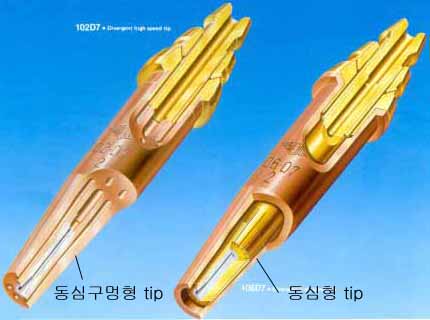|
산소-acetylene 절단
The oxy-acetylene cutting process is achieved by blowing away the molten material, which is melted by the
combustion heat of acetylene gas and oxygen. Generally, only steel material is cut using this process and
material of remarkable thickness can be cut. However, the thickness that can be cut is based on a user's skill
and the size of a torch used.
|
 ____________________________________________________________________________________________
____________________________________________________________________________________________
OXY-ACETYLENE CUTTING
The rules about personal protective equipment and fires and explosions that govern welding also apply to
oxy-acetylene cutting. Eye protection is mandatory for all employees using the torch. Do not use the
torch in explosive atmospheres or around combustible materials. Do not cut into an empty drum that
previously contained flammable gases or liquid unless it has been cleaned.
Other rules relating to the use of high-pressure gas bottles include:
Before starting a torch project, the employee shall inspect the equipment. The hoses, valves,
couplings, and tip connections shall be checked for damage and leaks.
During transportation, storage, or when in use, a compressed gas cylinder must always be secured
in an upright position. This is especially important for acetylene bottles, because the acetone in
them can corrode the valve assembly if laid on its side.
-
Full or empty gas cylinders not in use shall have their valves shut and the valve protection cap
screwed on.
Never use high pressure compressed oxygen in a cylinder for ventilation, comfort cooling,
blowing dust from clothing, or cleaning your work area. Pure oxygen greatly enhances the
combustibility of any fuel and accelerates the burning process. Also, take extra caution with
oxygen bottles to see that the valve assembly on top is not damaged by equipment or a fall. The
very high pressure of the escaping oxygen in the cylinder will propel it like a torpedo and destroy
most anything in its path.
When lifting cylinders with a rig, never wrap a choker or sling directly on the cylinder. Always
secure them in a cart, cradle, sling board, etc., for hoisting. Also, do not use the valve protection
cap for hoisting.
Oxygen cylinders must have their valve opened all the way for use. Acetylene valves, however,
must be opened not more than 1½ turns so they can be quickly turned off in an emergency.
Valves that utilize a T wrench must have the T wrench in place when in use.
Torches will be lit by strikers or friction lighters, not with matches, cigarettes, or from hot work.
|
 ____________________________________________________________________________________________
____________________________________________________________________________________________